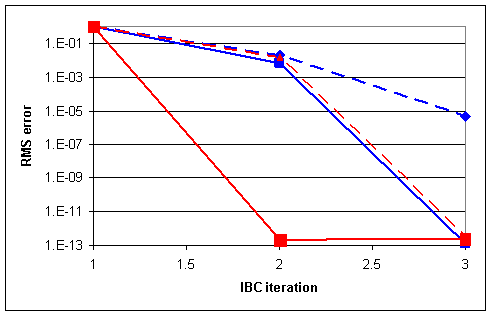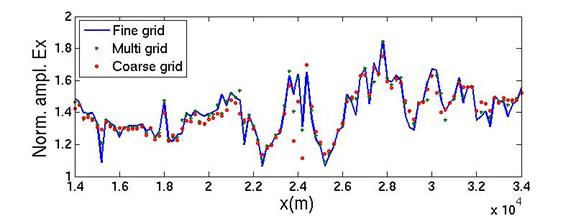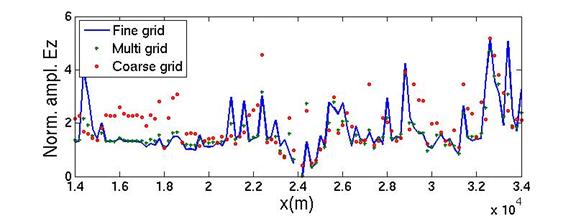Electromagnetic modeling of large
3D geological structures with inhomogeneous background conductivity
Martin Čuma, Masashi Endo, Ken Yoshioka and Michael S. Zhdanov
Introduction
Geophysicists study propagation of physical fields through the earth's interior in order to determine its structure. The most common fields used are gravitational, magnetic, electromagnetic and seismic waves. Numerical modeling of known geological structure to produce geophysical field data represents forward problem. The goal of geophysical interpretation is to determine unknown geology by use of observed values of the geophysical fields. This is called an inverse problem. In practice, performing inversion involves minimization of misfit between observed field data and field data calculated by forward model based on structural properties inferred from the inversion. Thus, research in both forward and inverse modeling methods form an important part of geophysics.
Our group concentrates on use of electromagnetic (EM) methods, which study propagation of electric currents and electromagnetic fields through the earth. Here, the geological structure is usually characterized by its conductivity or resistivity. The basis of the electromagnetic fields theory is governed by Maxwell's equations, which equate electric field E and magnetic field H to conductivity σ, electric permittivity ε and magnetic permeability μ. The forward problem can be described by following operator equation:
{E,H} = Aem{σ,ε,μ}, (1)
where Aem is operator of the forward electromagnetic problem.
Similarly, inverse problem can be represented as
{σ,ε,μ} = (Aem)-1{E,H}. (2)
Operator Aem is usually nonlinear. This leads to a set of integro-differential equations, which are solved in a discrete fashion on a 3D mesh.[1] In this article, we focus on recent progress with development of computationally efficient forward modeling methods.
Among the methods used to solve the forward problem we should mention Finite Elements (FE), Finite Difference (FD) and Integral Equation (IE) method. The IE method's main advantage over the former two is that one does not need to discretize the whole domain under study, but only usually much smaller domain of geological interest. The domain of interest is discretized on a 3D mesh with electromagnetic properties and fields calculated in each mesh cell. In the framework of the IE method, the conductivity distribution is divided into two parts: normal (background) conductivity σn and anomalous conductivity Δσa. Anomalous conductivity is considered only in the domain of interest, while normal conductivity is present throughout the whole model. The requirement for efficient method implementation using Green's functions necessitates use of horizontally homogeneous background. Fortunately, this situation is common as the anomaly of interest (ore deposit, hydrocarbon reservoir) is usually surrounded by layered uniform host rock.
EM survey typically consists of an array of receivers, which record earth response to EM signal transmitted by single or multiple transmitters, as seen in Figure 1. Solution of forward problem thus involves three distinct steps. First step calculates background fields induced on the receivers by the response of the homogeneous background. Second step calculates anomalous fields induced in the domain of interests. Finally, third step calculates fields on the receivers induced by the anomalous fields in the domain. The resulting field on the receivers is sum of the background field from step one and anomalous field from step three.

Figure 1. Vertical section model area with hydrocarbon reservoir and rough seafloor bathymetry. Survey receivers and transmitters are denoted with green and white dots, respectively. Sea water resistivity is 0.3 Ohm-m and subsurface background resistivity is 2 Ohm-m.
While the IE method is quite efficient compared to FE and FD, its main limitation is that its computational and memory requirements grow cubically with the increase of the domain dimension or with making the mesh finer (decreasing mesh cell size). Work on methods to alleviate this problem is ongoing. One of the recent contributions from our group is development of multi-grid (MG) approximation[2], which extrapolates electromagnetic fields on coarser grid (with larger cell size) to that on finer grid (with smaller, and thus more precise cell size).
In some applications, it is difficult to describe the
geological model using horizontally layered background. As a result, the domain
of interest may become too large for feasible calculation. We have recently
developed a computational method that allows us to use variable background
conductivity. In this article, we use this method, named Inhomogeneous
Background Conductivity (
Integral equation solution
using multigrid approach
As described in the introduction, we consider normal conductivity Δσn for the background and additional anomalous conductivity Δσa for the anomaly. For our discussion, we present derivations for the electric field E, similar equations can be obtained for magnetic field H. The integral representation of Maxwell's equations for total electric field E is
![]() , (3)
, (3)
where ![]() †is the electric
Green's tensor defined for an unbounded conductive medium with normal
conductivity σn, GE is corresponding Green's
linear operator, and domain D corresponds to the volume within the anomalous
domain with conductivity
†is the electric
Green's tensor defined for an unbounded conductive medium with normal
conductivity σn, GE is corresponding Green's
linear operator, and domain D corresponds to the volume within the anomalous
domain with conductivity
![]() ,
, ![]() .
.
The total electric field can be also represented as a sum of background and anomalous fields:
![]() . (4)
. (4)
Multigrid approach is based on
quasi-linear assumption that the anomalous field Ea is linearly
proportional to background field En through reflectivity tensor ![]() :
:
![]() . (5)
. (5)
Since the reflectivity tensor is linear, we can interpolate its value within the anomalous domain. We therefore solve the integral equation problem (3) on coarsely discretized grid Σc using complex generalized minimum residual method (CGMRM), obtaining background and anomalous fields at the coarse grid, En(rc) and Ea(rc). We calculate reflectivity tensor on coarse grid as
![]() ,(6)
,(6)
where i corresponds to x,y,z components and assuming that ![]() .
.
We then interpolate the reflectivity tensor to fine discretization grid Σf, and compute the anomalous electric field on the fine grid as
![]() . (7)
. (7)
We can now find the total electric field E(rf) on the fine grid as
![]() . (8)
. (8)
Finally, using discrete analog of formula (3), we compute observed fields on the receivers.
Accounting for bathymetry
with inhomogeneous background conductivity method
A topography structure is modeled as an inhomogeneous background domain B with conductivity σb = σn+Δσb; sum of horizontally layered (normal) conductivity σn and inhomogeneous conductivity Δσb. Consequently, Δσb within this domain generates field that induces additional field on the receivers and inside of the anomalous domain of interest A.
Total field at any point rj is then expressed as a sum of normal
field En, variable background effect ![]() †due to
†due to ![]() †due to anomalous
conductivity Δσa:
†due to anomalous
conductivity Δσa:
![]() , (9)
, (9)
where ![]() †and
†and ![]() †are Green's linear
operators for domain B and A, respectively.
†are Green's linear
operators for domain B and A, respectively.
Rewriting equation (9) for ![]() , we obtain equation for anomalous field in anomalous domain
A:
, we obtain equation for anomalous field in anomalous domain
A:
![]() (10).
(10).
In practice, we calculate field ![]() †in domain B ignoring
anomalous domain A, and use this field in equation (10) to obtain field
†in domain B ignoring
anomalous domain A, and use this field in equation (10) to obtain field ![]() †in domain A. We then
use equation (9) to get total field in the domain, and analog of equation (3) to
calculate field at the receivers.
†in domain A. We then
use equation (9) to get total field in the domain, and analog of equation (3) to
calculate field at the receivers.
To improve accuracy, we can use this scheme iteratively.
First iteration is performed as described above. Second iteration calculates
field in domain B including the induction effect from anomalous field in domain
A obtained at first iteration. The problem is then run until self consistency
is reached for both anomalous fields ![]() †and
†and ![]() .
.
Application of
We have incorporated the MG and
Sarawak Shell Berhad, Shell
International Exploration and Production, and PETRONAS Managing Unit performed
a bathymetry survey over geologically favorable target reservoirs in

Figure 2. Bathymetry
relief of the

Figure 3. A model of a hydrocarbon reservoir located within the conductive sea-bottom sediment.
The EM fields in this model are generated by a horizontal
electric dipole (
The survey area was represented by two modeling domains, Da and Db, outlined by the green dashed lines in Figure 1. Modeling domain Db covers the area with conductivity variations associated with the bathymetry of the sea-bottom, while modeling domain Da corresponds to the location of the hydrocarbon reservoir. We used 7,193,600 (1124 x 200 x 32) cells with each cell size 50 x 50 x 20 m for discretization of the bathymetry structure. The domain Da of the hydrocarbon reservoir area was discretized by 1.5 million cells (400 x 240 x 16) with each cell size of 25 x 25 x 6 m to represent accurately the reservoir structure of the model.
Evaluating this model by any conventional IE method would
require simultaneous solution of the corresponding system of equations on a
grid formed by at least a combination of the two domains, Da
and Db. Application of the
To assess feasibility of the MG approach for bathymetry
study, we ran one calculation using MG approximation. We also ran two explicit
calculations, one fine grid discretization as detailed
above, and other using coarse grid with twice the cell size (thus 8 times less
cells) than the fine grid. The convergence plot of the iterative

Figure 4. Convergence plot for the


Figure 5. In-line (x direction) and vertical (z direction) electric fields along MCSEM profile.
Figure 5 shows total in-line and vertical electric field
amplitudes along the MCSEM profile (y=5,000 m) at last
Computational requirements
The most computationally demanding part of the PIE3D code is
calculation of anomalous electric field in the domains Da
and Db. The limiting factor here is actually not as much the
computation time, as the memory requirements to store the system of linear
equations that describe the problem. In the fine grid calculation, for the larger
bathymetry domain Db, the required memory amounts 132 GB, for the
smaller anomalous domain Da, it equals 14
GB. Disk requirements for the intermediate data storage are also not
negligible. Although the program uses efficient file compression algorithms,
the total disk usage was about 400 GB. We have run the fine grid calculation on
In comparison, the MG calculation used just 24 nodes, 40 GB of disk space and needed about two hours to finish. Running on more nodes would probably not improve the performance significantly since the parallelization in current PIE3DMG code is limited to one domain dimension (z) and three field components. One of our future goals is to extend parallelizability to other dimensions and to transmitters and receivers. However, even it its current incarnation, MG provides viable alternative to fine grid modeling in case resources are scarcer or one needs to get the result faster.
Conclusions
In this research project, we have developed a parallel
implementation of new integral equation (IE) method. This new method can
improve the accuracy of the solution by iterative
We have applied a new parallel code based on the
Another advantage of the
covering the anomalous domain only. In addition, the multi grid approach can compute EM fields with even less computational cost without significant compromise in accuracy.
Acknowledgement
The authors acknowledge support of the
References